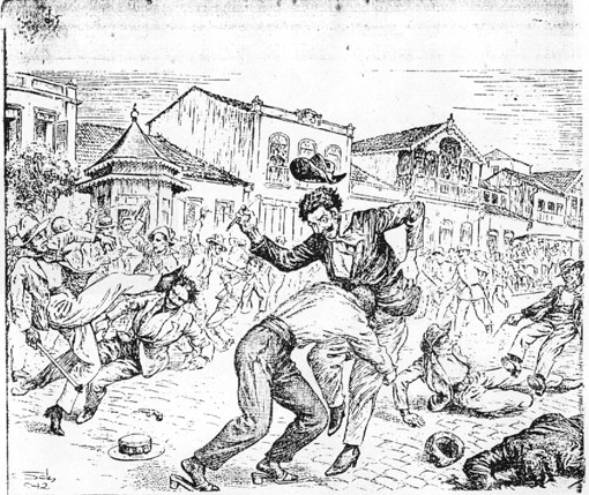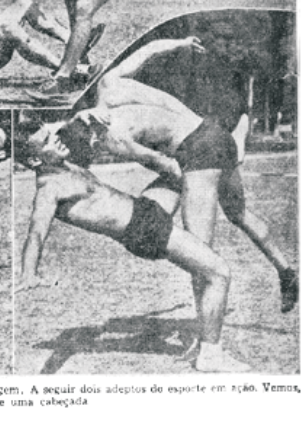
I found out people still read my basic article 'Can cabeçada be used in combat?'
And it makes sense - at present, I tend to dwell more on the 'esoterics of capoeiragem'; while people still want to learn about the basics.
So this is another 'basics' article, in a sense, continuation of 'Can cabeçada be used in combat?' It will also explain the difference between good and bad cabeçadas
It is important to understand that every good cabeçada - the ones I show in my videos, basically - has a feature I call Nerve binding.
Without going into details, laconically, Nerve binding neurally locks opponent's arms to the sides when you execute the cabeçada into him; this means he cannot reach your face with his hands.
Now why should he touch your face, you ask? Well, to gouge your eyes. To fishhook your mouth or your nose and tear it. To grab and tear off your ears. To grab your hair and pull you down by it. There is whole slew of nasty things the opponent can do to your face once you stick it close enough to his hands.
And that is when he is barehanded. If he has a straightrazor or a knife, he can poke your eye out, slice your face to ribbons or finish the deal by cutting your carotid artery.
And the only thing that protects you from all this - when you execute a good cabeçada - is Nerve binding. Nerve binding is that important. It makes or breaks a combat-usable cabeçada.
https://www.youtube.com/watch?v=cWB-pWdaLQ8
Cabeçada solta. With Nerve binding, of course.

Double-leg cabeçada (link) - it has nerve binding too, naturally; otherwise, that razor would be in the headbutter's throat by now
This also tells us what is a bad cabeçada: It is a cabeçada that lacks Nerve binding; so the opponent can have a field day tearing your face to shreds when you have the bright idea to stick it close to him. It is a cabeçada unusable in real combat.
There are many 'cabeçadas' that lack Nerve binding; and thus are bad, ie unusable in combat. They are those cabeçadas I do not show in my videos. And I strongly advise you to never use them (even in jogo; as you can easily build bad habits).
And realize this, my dear reader: 90% of 'cabeçadas' modern 'Mestres of capoeira' show lack Nerve binding; ie they are bad cabeçadas. Real capoeiras from 19th century would not even spit on the 'cabeçadas' shown by the contemporary Mestres.
Of course, you can say it is their (the Mestres') 'malandragem'; that they purposefully show bad stuff in roda so they can use good stuff on the street.
Yet, even if it is true, this is not going to help you when you actually use the 'cabeçadas' these Mestre teach you on the street; and get your face ripped away.
Examples:
https://www.youtube.com/watch?v=TXFczXfxi-A
https://www.youtube.com/shorts/MGhkm1GFPeU
https://youtu.be/cSbZ5YmL5S8?t=105
These cabeçadas will get your eyes gouged or your throat cut when it is for real.
-
This man
https://www.youtube.com/watch?v=LlpPKt3H3Yk
teaches two good - ie old - cabeçadas:
-Tiger cabeçada to the nose from clinch (1:48) (our video) and
-Straight Bahian Rooster+Seduction1 cabeçada (3:30) (our video)
and six bad ones (3:27, 4:40, 5:10, 5:20, 5:55, 6:04, 6:20 - here, you are going to get your face bitten off for a change).
Are you willing to take the gamble?
I do not have anything personal against the man, but he clearly does not understand what he is teaching; and this seems to be the rule rather than exception.
Where does the double leg takedown fit in, you ask. Well, double leg has two similarities with bad cabeçadas:
-you stick your face close to the opponent's hands
-it lacks nerve binding
That means, if you shoot a double on your opponent, he can be nice and keep his hands off your face. Then you take him down and everything is OK, I guess.
Or he can be not-nice and shred your face before you hit the ground.
-
This man has built a system around this, in the case you do not believe me it is done
https://youtu.be/zgRqjF-OCRY?t=442
Do not duplicate what he is doing; it is an evil method of fighting. Just imagine throwing one of the modern cabeçadas against this man - and on the street, you can expect evil guys like him to attack you.
-
Or, if he has a knife, your carotid artery is very conveniently positioned so he can cut your throat in one movement.
Oh, I know they do not do this in MMA. But that is precisely the point - they do not do it in MMA, because it is forbidden by rules in MMA. This is why double leg takedown is a good idea in MMA.
However, when you shoot double leg takedown on a stranger in the street, you are relying on an unspoken contract he will not gouge your face. If you have such contract with your opponent, I guess it is OK to shoot a double on the street too.
--
Yet, there was no such general contract in the streets of 19th century Rio/Bahia; this is why real capoeiragem only ever used good cabeçadas, ie cabeçadas with Nerve binding; and no double leg takedowns.
That should allow you to understand why cabeçada is better than a double leg takedown (for street fighting).
And also, why you should toss most 'cabeçadas' they teach you today in capoeira into a trashcan; yesterday was too late.
As to why (good) cabeçada is better than double leg takedown, you should know by now: Because shredder.
Cabeçada is also better tactically; because you remain standing while the opponent goes to the ground.
But - and we get back to this - this only applies for good cabeçadas, ie the ones with Nerve binding. In bad cabeçadas - without Nerve binding - the opponent can (and will) grab you and pull you to the ground with him.
If you are going to stick your head into opponent's body in combat - and you are, if you are a capoeiragem fighter, that is how you roll - the movement better has Nerve binding!
And if you do not believe me - well, look at the old capoeiragem cabeçadas. They all have Nerve binding - this is hardly a coincidence.
Bonus - ixprimenti!
If you want, you can try the following training method - or rather, quality testing method.
Get into the habbit that every time your training partner sticks his head close to you, seize his hair(or ear, if he has no hair); and use the index finger of your other hand to slide under his chin, mimicking cutting his throat. Keep doing it whenever you can; to show him he is vulnerable. (You could, of course, just try to gouge his eyes for the same effect. But since this technique is evil, I do not recommend it even for training).
This should allow you to determine how safe the cabeçadas you are taught really are. And you can try it against a double leg, too.
Excursus:
There is something inhuman in gouging opponent's face like that; this is why most nice people intuitively avoid it. This is also why the bad cabeçadas seem to work so well in roda.
Yet, you cannot count on your opponent being nice to you. In fact, most people you are going to fight are probably going to be evil. Therefore, you can expect them to try funny things such as this against you.
Excursus:
This is Rudolf Hermanny, pupil of Mr. Sinhozinho, demonstrating a 'cabeçada':

Now guess which type of cabeçada it is - a good one or a bad one? You can try it out for yourself using the above experiment; but I can save you the hassle: It is a bad cabeçada. You can, in fact, see it right away - look at the way Hermanny's opponent hangs on his head with his left arm. Imagine he would really want to hurt Hermanny; just grabbing his ear would be enough, the fall would do the rest.
While I do not have anything personal against Mr. Hermanny - without him, I would probably not have Flying 41! - this is one of the clues that everything was not alright with Sinhozinho's 'Capoeira Utilitariana'.
In my humble opinion, no real old Carioca fighter - or even general old capoeira fighter! - would ever use this 'cabeçada'. It is simply wrong.
This Web Page was Built with PageBreeze Free HTML Editor